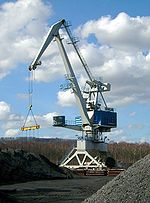
Level luffing crane
Encyclopedia
A level-luffing crane is a crane mechanism where the hook remains at the same level whilst luff
ing; moving the jib up and down, so as to move the hook inwards and outwards relative to the base.
Some types of crane are inherently level-luffing: those with a fixed horizontal jib, such as gantry
, hammerhead or the fixed-jib tower cranes commonly used in construction. Usually though, the description is only applied to those with a luffing jib that have some additional mechanism applied to keep the hook level when luffing.
Level-luffing is most important when careful movement of a load near ground level is required, such as in construction or shipbuilding. This partially explains the popularity of fixed horizontal jibs in these fields.
engineer in 1914. This is also a purely mechanical linkage, arranged by the reeving of the hoist cables to the jib over pulleys at the crane's apex above the cab, so that luffing the jib upwards allows more free cable and lowers the hook to compensate.
 The usual mechanism for level-luffing in modern cranes is to add an additional "horse head" section to the top of the jib. By careful design of the geometry, this keeps level merely by the linked action of the pivots.
The usual mechanism for level-luffing in modern cranes is to add an additional "horse head" section to the top of the jib. By careful design of the geometry, this keeps level merely by the linked action of the pivots.
Later systems have used modern electronic controls and quickly reversible motors with good slow-speed control to the hoist winch motors, so as to give a positioning accuracy of inches. Some early systems used controllable hydraulic gearboxes to achieve the same result, but these added complexity and cost and so were only popular where high accuracy was needed, such as for shipbuilding.
These are used for tasks such as ship unloading, where the view from the driver's cab is greatly improved by cantilevering it forwards and over the ship.
models, and luffing cranes are no exception.
Luff
Luff or luffing may refer to:* Luffing, when a sailing sheet is eased so far past trim that airflow over the surface is disrupted* The leading edge of a sail...
ing; moving the jib up and down, so as to move the hook inwards and outwards relative to the base.
Some types of crane are inherently level-luffing: those with a fixed horizontal jib, such as gantry
Gantry crane
Gantry cranes, bridge cranes, and overhead cranes, are all types of cranes which lift objects by a hoist which is fitted in a hoist trolley and can move horizontally on a rail or pair of rails fitted under a beam...
, hammerhead or the fixed-jib tower cranes commonly used in construction. Usually though, the description is only applied to those with a luffing jib that have some additional mechanism applied to keep the hook level when luffing.
Level-luffing is most important when careful movement of a load near ground level is required, such as in construction or shipbuilding. This partially explains the popularity of fixed horizontal jibs in these fields.
Toplis cable luffing
An early form of level-luffing gear was the "Toplis" design, invented by a Stothert & PittStothert & Pitt
Stothert & Pitt were a British engineering company founded in 1785 in Bath, England. They were the builders of a variety of engineering products ranging from Dock cranes to construction plant and household cast iron items. They went out of business in 1989...
engineer in 1914. This is also a purely mechanical linkage, arranged by the reeving of the hoist cables to the jib over pulleys at the crane's apex above the cab, so that luffing the jib upwards allows more free cable and lowers the hook to compensate.
Horse-head jibs

Powered level-luffing
As cranes and their control systems became more sophisticated, it became possible to control the level of luffing directly, by winching the hoist cable in and out as needed. The first of these systems used mechanical clutches between luffing and hoist drums, giving simplicity and a "near level" result.Later systems have used modern electronic controls and quickly reversible motors with good slow-speed control to the hoist winch motors, so as to give a positioning accuracy of inches. Some early systems used controllable hydraulic gearboxes to achieve the same result, but these added complexity and cost and so were only popular where high accuracy was needed, such as for shipbuilding.
Luffing cabs
Luffing mechanisms have also been applied to the driver's cab being mounted on its own jib, following the movement of the crane's main jibThese are used for tasks such as ship unloading, where the view from the driver's cab is greatly improved by cantilevering it forwards and over the ship.
Meccano models
Cranes have long been a popular subject for MeccanoMeccano
Meccano is a model construction system comprising re-usable metal strips, plates, angle girders, wheels, axles and gears, with nuts and bolts to connect the pieces. It enables the building of working models and mechanical devices....
models, and luffing cranes are no exception.

